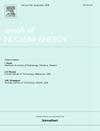葡萄糖溶胶-凝胶法制备适于凝胶微球的UCO溶胶
IF 1.9
3区 工程技术
Q1 NUCLEAR SCIENCE & TECHNOLOGY
引用次数: 0
摘要
燃料元件的设计、开发和制造以其安全性、可靠性、延长使用寿命和高燃燃能力为特征,构成了第四代反应堆研究和开发努力范围内的关键组成部分。与更传统的二氧化铀相比,铀氧化物(UCO)燃料以其优越的导热性和更高的铀含量脱颖而出,使其成为这些先进核反应堆的理想候选者。这种铀基燃料核的制造取决于一个关键步骤,即铀溶胶的制备,这对凝胶颗粒的分散有重大影响,并最终影响最终产品的质量。本研究以葡萄糖为碳源,采用外凝胶法结合碳热还原法制备UCO陶瓷微球。结果表明,在反应温度为80℃、尿素与铀的摩尔比(CO(NH2)2/U(VI))为3.1 ~ 3.3、铀浓度为1.6 ~ 2.4 m的条件下,铀溶胶可以分散成凝胶球,加入适量的四氢糠醇可以有效地解决凝胶球中的裂化问题。最后,通过适当的分散和热处理,制备出微观结构均匀的UCO陶瓷微球。本文章由计算机程序翻译,如有差异,请以英文原文为准。
Preparation of UCO sols suitable for gelation into microspheres by sol–gel process with glucose
The design, development, and fabrication of fuel elements characterized by their safety, reliability, extended service life, and high burnup capabilities constitute a critical component within the scope of fourth-generation reactor research and development endeavors, the uranium carbon oxide (UCO) fuel stands out with its superior thermal conductivity and a higher uranium content compared to the more traditional uranium dioxide, making it an ideal candidate for these advanced nuclear reactors. The fabrication of such uranium-based fuel kernels hinges on a crucial step, which is the preparation of the uranium sol, which significantly affects the dispersion of the gel particles and, ultimately, the quality of the final products.
The objective of this study was to prepare UCO ceramic microspheres using glucose as a carbon source by the external gelation method combined with carbothermal reduction. Additionally, the results demonstrated that uranium sol could be dispersed into gel spheres at a reaction temperature of 80 °C, the molar ratio of urea to uranium (CO(NH2)2/U(VI)) is between 3.1–3.3, and the uranium concentration of 1.6–2.4 M. Moreover, adding an appropriate amount of tetrahydrofurfuryl alcohol was proven effective in resolving the cracking issue observed in the gel spheres. Finally, UCO ceramic microspheres with homogeneous microstructures could be prepared through appropriate dispersion and heat treatment.
求助全文
通过发布文献求助,成功后即可免费获取论文全文。
去求助
来源期刊

Annals of Nuclear Energy
工程技术-核科学技术
CiteScore
4.30
自引率
21.10%
发文量
632
审稿时长
7.3 months
期刊介绍:
Annals of Nuclear Energy provides an international medium for the communication of original research, ideas and developments in all areas of the field of nuclear energy science and technology. Its scope embraces nuclear fuel reserves, fuel cycles and cost, materials, processing, system and component technology (fission only), design and optimization, direct conversion of nuclear energy sources, environmental control, reactor physics, heat transfer and fluid dynamics, structural analysis, fuel management, future developments, nuclear fuel and safety, nuclear aerosol, neutron physics, computer technology (both software and hardware), risk assessment, radioactive waste disposal and reactor thermal hydraulics. Papers submitted to Annals need to demonstrate a clear link to nuclear power generation/nuclear engineering. Papers which deal with pure nuclear physics, pure health physics, imaging, or attenuation and shielding properties of concretes and various geological materials are not within the scope of the journal. Also, papers that deal with policy or economics are not within the scope of the journal.
 求助内容:
求助内容: 应助结果提醒方式:
应助结果提醒方式:


